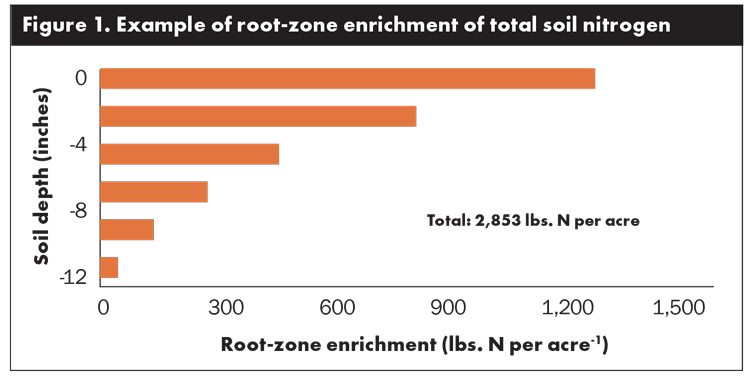Organic matter is no small matter |
| By Alan Franzluebbers |
|
|
|
The author is a soil scientist with the USDA Agricultural Research Service in Raleigh, N.C.  When evaluating the quality of land for farming, one of the key features of interest will be its organic matter content. Soil organic matter may be 1% to 4%, so it might be considered a small and inconsequential portion of soil. This dismissal may be understandable when you know that soil clay content can vary from near nothing to upward of 30% and has a large bearing on the trafficability of land or the extent of mud that develops during rainy periods. But what is soil organic matter, really? How much difference can a few percentage points mean to the fertility of soil? Let’s dig in a bit deeper to reveal some unique characteristics of this relatively small, yet very important, part of soil. Composition, transformation Soil organic matter is mostly composed of carbon, hydrogen, oxygen, and nitrogen. Various other minor elements are also associated in a complex arrangement of what seems to be a random assembly of molecules throughout the soil matrix. Soil organic matter has an ill-defined biochemical structure because it is constantly in varying states of accumulation and decomposition. Unique environmental conditions in and among fields ultimately determine soil organic matter structure and the balance of its constituents. All soil organic matter was once either plant or animal tissues that have since partially decomposed. Through decomposition, it becomes a dark material that takes on its own nature. Soil organic matter can also be thought of as the breakdown products and residues of various soil microorganisms that live and die as a part of the decomposition process. In fact, much of the denser soil organic matter material may be comprised of dead cells of various bacteria and fungi — some of the smallest organisms that require a microscope to be seen. Microorganism impacts Soil organic matter is a reactive substance that serves many purposes, allowing soil to function more effectively. A key function of it is nutrient supply and storage within the context of natural soil fertility. Plant and animal remains may be initially consumed by voles, earthworms, and a variety of insects like beetles, flies, and springtails. Those masticated particles are then more dominantly consumed by bacteria and fungi, and these microorganisms utilize the energy in these organic materials to grow.  Growth and decay of bacteria and fungi leave behind nutrients that plants can utilize once again. The cycling of nutrients from those elements that are initially obtained in soil water by plant roots are translocated into the stems of plants and transformed into proteins and carbohydrates in leaves. This is the plant uptake part of the cycle that embodies soil fertility. The feeding of plant materials to animals, either those you manage on pastures or wildlife and insects that also consume their share, begins the return of nutrients back to the soil through feces and damaged plant materials that are then consumed by the large variety of primary decomposers in soil. This is the decomposition part of nutrient cycling. Surface concentration Soil organic matter is typically concentrated near the soil surface, and its concentration declines with depth in the soil profile. This general feature of soils is controlled by plant inputs. Plant leaves, stems, and roots provide the carbon backbone of organic matter inputs. Fewer carbon inputs deeper in the soil limit how much organic matter can accumulate. Soil microorganisms consume these carbon inputs, and their activity is also concentrated near the soil surface. This is partly because they require carbon inputs to feed their activities, but they also need warm temperatures, moist soil, and abundant oxygen to optimize their activity. Soil organic matter accumulates near the soil surface when organic matter inputs exceed the decomposition potential of microorganisms. This can occur when temperature, moisture, and oxygen are limited. These environmental conditions can also limit plant growth, so the balance is essential. Robust plant density can shade the soil surface, keeping it cool; however, abundant plant growth can rapidly dry soil keeping soil microorganisms at a disadvantage over time. Nitrogen content Organic matter in agricultural soils contains 10 to 15 parts of carbon for every part of nitrogen. This natural balance is typified with 58% of soil organic matter as carbon and 5% of soil organic matter as nitrogen. The ratio of carbon to nitrogen is then typically 11.6. The quantity of nitrogen stored in soil organic matter can be exemplified from a recent evaluation of 31 farms in central and western Virginia. In the top 4 inches, soil contained 1,628 pounds of nitrogen per acre at the low end and 3,399 pounds of nitrogen per acre at the high end (10th and 90th distribution limits, respectively). In the 4-to-8-inch depth, total nitrogen was 1,021 and 1,851 pounds per acre at low and high ends. In the 8-to-12-inch depth, total nitrogen was 593 and 1,259 pounds per acre at low and high ends. Summed within the surface foot of soil, there were 3,241 and 6,509 pounds of nitrogen per acre at low and high ends. That’s a lot of nitrogen! In this example, soil organic matter levels at a 0-to-6-inch depth were 2.3% and 4.7%, respectively, for these two extremes of soil condition. Not all of the nitrogen stored in soil organic matter is readily available for plant uptake, though. Nitrogen in soil organic matter must be decomposed by soil microorganisms. This is the process of nitrogen mineralization, which will be discussed in more detail in an upcoming issue. • This article appeared in the November 2024 issue of Hay & Forage Grower on pages 14-15. Not a subscriber? Click to get the print magazine. |
